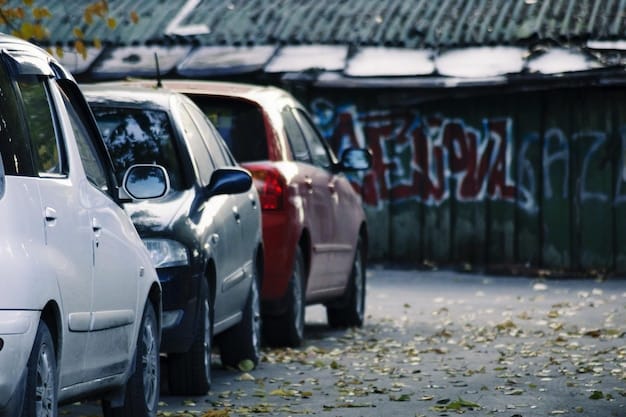School Zone Parking: Avoid Tickets with This Comprehensive Guide

School zone parking regulations are designed to protect children by ensuring clear visibility and safe pedestrian access; understanding these rules can help drivers avoid costly tickets and towing fees, contributing to safer school environments.
Navigating school zone parking regulations can be tricky, but understanding the rules is crucial to ensure the safety of children and avoid unnecessary fines. This comprehensive guide provides everything you need to know about school zone parking, from deciphering signs to understanding local ordinances.
Understanding School Zone Parking Regulations
School zones are areas near schools where specific traffic regulations are in place to protect students. Parking regulations in these zones are often stricter than in other areas, and it’s important to be aware of the rules to avoid penalties.
These regulations can vary significantly from one city to another, and even from one school to another within the same city. Paying close attention to posted signs and local ordinances is essential for every driver.
The Importance of School Zone Parking Rules
The primary goal of school zone parking regulations is to ensure the safety of children. By creating clear visibility and reducing congestion, these rules help protect students walking, biking, or being dropped off and picked up from school.
Key Elements of School Zone Parking
- Timing Restrictions: Many school zones have parking restrictions that are in effect only during specific hours, typically when students are arriving or leaving school.
- No-Parking Zones: These are areas where parking is strictly prohibited during certain hours to maintain clear visibility and traffic flow.
- Loading Zones: Designated areas for parents to quickly drop off or pick up their children, often with short time limits.

Understanding these key elements can help drivers navigate school zones more safely and effectively, ensuring the well-being of students and avoiding costly parking tickets.
Deciphering School Zone Parking Signs
One of the most crucial aspects of avoiding parking tickets in school zones is being able to accurately read and understand the parking signs. These signs provide essential information about when and where parking is allowed or restricted.
Many drivers get caught out because they fail to fully understand the signs or assume the rules are the same as other areas. Here’s what to look for:
Common Signage and Their Meanings
School zone parking signs often use specific symbols and wording to convey important information. Understanding these is key to compliance.
Interpreting Time Restrictions
Time restrictions indicate when the parking regulations are in effect. These are usually specified with start and end times, such as “7:00 AM – 9:00 AM” or “2:00 PM – 4:00 PM.”
- Days of the Week: Signs often specify the days of the week when the restrictions apply, for example, “Mon-Fri.”
- Holidays and School Breaks: Be aware that parking regulations may still be in effect during school holidays and breaks, unless specifically stated on the sign.
- Metered Parking: Where parking meters are present, ensure you pay the required fee and adhere to the time limits.
By paying attention to these signs, drivers can avoid misunderstandings and ensure they are parking legally and safely in school zones.
Common School Zone Parking Violations
Despite clear signage, many drivers still commit parking violations in school zones. Understanding these common mistakes can help you avoid making them yourself and incurring costly fines.
Familiarizing yourself with the common violations is the best preventative measure for parking legally and safely.

Parking in No-Parking Zones
No-parking zones are strictly enforced areas where parking is prohibited during specified times. These are usually marked with red paint on the curb and signs indicating the restriction. Ensure your vehicle is completely outside this area during the restricted times.
Exceeding Time Limits in Loading Zones
Loading zones are designed for quick drop-offs and pick-ups. Exceeding the posted time limit, even by a few minutes, can result in a ticket. Set a timer on your phone to help you keep track of the allowed time.
- Double Parking: Parking alongside a vehicle that is already parked on the street is illegal and highly dangerous, obstructing traffic flow and visibility.
- Blocking Crosswalks: Parking in a manner that blocks or obstructs a crosswalk is a serious violation, endangering pedestrians, especially children.
- Parking Too Close to Intersections: Parking too close to an intersection can reduce visibility for other drivers and pedestrians, leading to accidents.
Knowing these violations and taking proactive measures can save you from penalties and promote safer school environments.
Understanding Local Ordinances and Regulations
Parking regulations can vary significantly from city to city, and even within different school districts in the same city. It’s essential to understand the specific local ordinances that apply to the school zones in your area.
Local ordinances provide detailed rules that may not be fully covered by standard signage. Staying informed is key.
Checking City and County Websites
Many cities and counties provide detailed information about parking regulations on their official websites. Look for sections related to traffic, parking, or school zones to find the most current rules.
Contacting Local Authorities
If you have specific questions or need clarification about parking regulations, contacting local traffic enforcement or the city council can provide valuable information. Prepare your questions in advance to make the most of the conversation. If you’re still unsure, ask for documentation that supports the guidelines to reference later on.
- Attending Community Meetings: Local community meetings often discuss traffic and parking issues. Attending these meetings can provide insights into proposed changes and allow you to voice your concerns.
- Reviewing School District Policies: Some school districts publish their own parking policies for areas around schools. Reviewing these policies can give you a better understanding of their regulations.
By staying informed and proactive, you can ensure that you are always in compliance with local parking rules and contribute to a safer environment for students.
Strategies for Avoiding Parking Tickets in School Zones
Avoiding parking tickets in school zones requires a combination of awareness, planning, and caution. By implementing effective strategies, you can minimize your risk of violations and fines.
Being vigilant and prepared can save you time, money, and unnecessary stress. Here are some strategies to help:
Arriving Early
Arriving early allows you to find legal parking spots without rushing, reducing the temptation to park illegally. Give yourself plenty of time to drop off or pick up your children and avoid the last-minute scramble.
Planning Your Route
Familiarize yourself with the parking options around the school ahead of time. Identify designated parking areas, loading zones, and any potential restrictions along your route.
- Utilizing Drop-Off Zones: Take advantage of designated drop-off and pick-up zones, but be mindful of the time limits and traffic flow.
- Walking or Biking: If feasible, consider walking or biking with your children to school. This not only avoids parking issues but also promotes a healthy lifestyle.
- Carpooling: Organize carpools with other parents to reduce the number of vehicles around the school. This can ease congestion and make parking easier for everyone.
By planning ahead and considering alternative transportation methods, you can significantly reduce your chances of receiving a parking ticket in a school zone.
Consequences of Violating School Zone Parking Regulations
Violating school zone parking regulations can result in various consequences, ranging from fines to vehicle impoundment. Understanding these potential penalties can provide a clear incentive to comply with the rules.
Knowing the possible repercussions underscores the importance of adhering to parking regulations in school zones. Fines and other penalties apply to those who fail to follow the parking regulations within a school zone.
Fines and Penalties
Parking tickets in school zones often carry higher fines than those in other areas due to the increased safety risks. Fines can range from $50 to $500 or more, depending on the severity of the violation and local ordinances.
Vehicle Impoundment
In some cases, vehicles parked in violation of school zone regulations may be towed and impounded. This can result in additional fees for towing and storage, on top of the parking fine. Illegally parking in a no-parking zone can be very costly especially if you need your vehicle to continue your day.
- Points on Your Driving Record: Some parking violations may result in points being added to your driving record, which can lead to increased insurance rates. Be careful when thinking about parking in a school zone.
- Court Appearances: Repeat offenders or those contesting their tickets may be required to appear in court. This leads to further cost and inconvenience for those who think they can skirt these rules.
Being aware of these potential consequences can motivate drivers to exercise caution and adhere to parking regulations, ensuring the safety of students and avoiding unnecessary penalties.
Violating school zone parking regulations not only comes with legal and financial consequences but also poses significant safety risks to students. By understanding and adhering to these regulations, drivers contribute to a safer environment for children walking, biking, or being dropped off and picked up from school.
| Key Point | Brief Description |
|---|---|
| 🚦 Signage | Understand school zone parking signs to avoid misunderstandings. |
| ⏰ Time Limits | Adhere to time restrictions to prevent violations in loading zones. |
| 🅿️ No Parking Zones | Avoid parking in prohibited areas for student’s safety. |
| 📍 Local Rules | Stay updated on the local parking regulations for school zones. |
Frequently Asked Questions (FAQs)
▼
School zone parking regulations prioritize students’ safety by maintaining visibility and managing traffic, preventing accidents during peak hours.
▼
Enforcement varies; confirm with local authorities. Some rules are relaxed during holidays and breaks, but always verify signage.
▼
Carefully review the ticket, understanding violation details. Determine the best course of action, typically paying or formally contesting the ticket.
▼
Check city or county websites’ traffic or parking sections. Contact local authorities or review school district policies for compliance details.
▼
Loading zones facilitate quick, safe drop-offs and pick-ups, easing congestion. Compliance with time limits is essential to prevent parking violations.
Conclusion
Understanding and adhering to school zone parking regulations is paramount for ensuring students’ safety and avoiding costly penalties. By staying informed, planning your routes, and being mindful of parking signs and local ordinances, you can contribute to a safer and more organized school environment.





